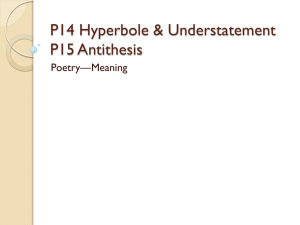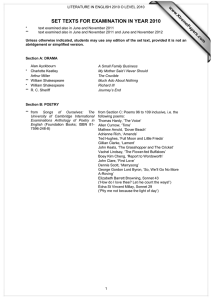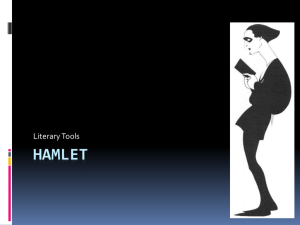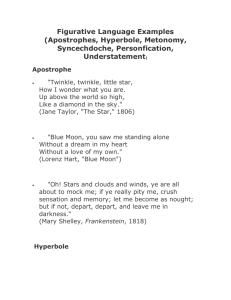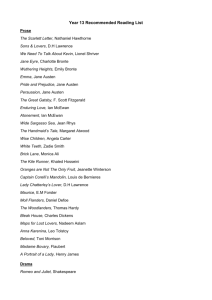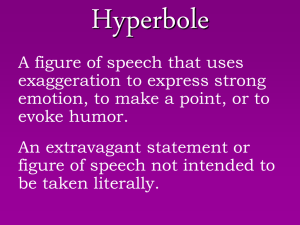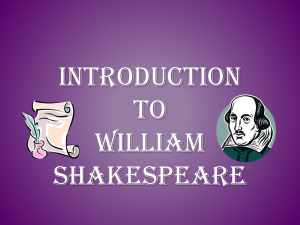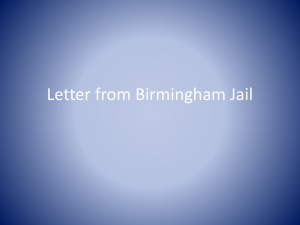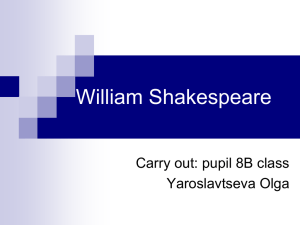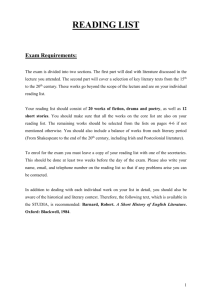Figures of Speech in Literature: Definitions & Examples
advertisement
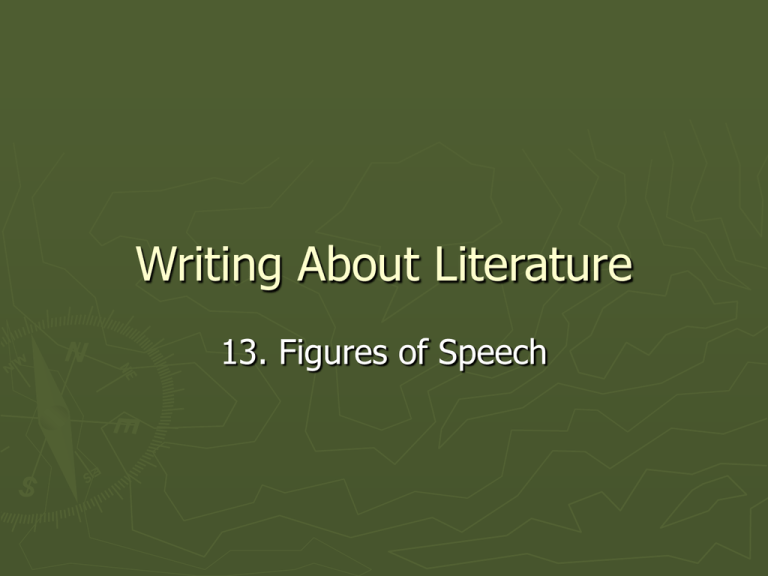
Writing About Literature 13. Figures of Speech Definition ► A figure of speech is the use of words that diverge from their literal meaning ► The figurative meaning may be achieved through special repetition arrangement or omission of words ► Figures of speech are used by poets to achieve freshness of expression or insight ► They can also introduce a desirable ambiguity between literal and figurative interpretation. ► The most common figures of speech in poetry are metaphor and simile Other Figures of Speech: Metonymy ► A figure of speech in which one thing is referred to by something else which is closely associated with it, like “crown” for a king or “sweat” for hard work or “Hollywood” for the film industry. ► Example: Doublet and hose ought to show itself courageous to petticoat. from As You Like It by William Shakespeare Other Figures of Speech: Synecdoche ► A figure of speech in which a part is used to signify the whole, as in “hired hands” for workers or “The Pentagon” for the Department of Defense. ► Example: Cars roll past all stuffed with eyes. from Soul Kitchen by Jim Morrison I should have been a pair of ragged claws Scuttling across the floors of silent seas. from The Love Song of J. Alfred Prufrock by T. S. Eliot Other Figures of Speech: Personification ► Anthropomorphism: Ascribing human characteristics to something that is not human, such as an animal or a god ► Zoomorphism: Applying animal characteristics to humans or gods ► Objectification: to refer to a human or other living thing as an object ► Example: all at once I saw a crowd, A host, of golden daffodils; from I wandered lonely as a cloud by William Wordsworth Ah, happy, happy boughs! that cannot shed Your leaves, nor ever bid the Spring adieu; from Ode on a Grecian Urn by John Keats Anthropomorphic animals can be found in works like Lord of the Rings and Orwell’s Animal Farm Other Figures of Speech: Over/understatement ► Meiosis: the use of understatement The Black Knight scene from Monty Python and the Holy Grail ("It's just a flesh wound!") ► Litotes: understatement that emphasizes the magnitude of something by denying its opposite No, Godzilla is not just another alligator in the sewers! ► Hyperbole: the use of overstatement I would / Love you ten years before the Flood; And you should, if you please, refuse Till the conversion of the Jews. from To His Coy Mistress by Andrew Marvell ► Adynaton: hyperbole taken to such extreme lengths as to suggest a complete impossibility Other Figures of Speech: Sensuality ► Onomatopoeia: A word that imitates or suggests the source of the sound that it describes ► Examples: Many machine sounds like “honk” or “beep-beep” for the horn of an automobile. Comic book sounds like “kersplat,” “bam,” “pow” and “wham.” Word like “snap, crackle, pop.” For animal sounds, words like buzz (bee), quack (duck), bark (dog), roar (lion) and meow (cat) are typically used in English. ► Synesthesia: Description of one kind of sense impression by using words that normally describe another …sunburnt mirth! / O for a beaker full of the warm South! from Ode to a Nightingale by John Keats Other Figures of Speech: Puns ►A form of word play which suggests two or more meanings, by exploiting multiple meanings of words, or of similar-sounding words ► Example: Now is the winter of our discontent made glorious summer by this son of York from Richard III by William Shakespeare Other Figures of Speech: Apostrophe ► Addressing a thing, an abstraction or a person not present ► Example: Death, be not proud, though some have called thee / Mighty and dreadful, for thou art not so from Holy Sonnet X by John Donne Roll on, thou dark and deep blue Ocean – roll! from Childe Harold's Pilgrimage by Lord Byron Other Figures of Speech: Oxymoron ► Using two terms together, that normally contradict each other ► Example: O brawling love, O loving hate, O any thing of nothing first create! O heavy lightness, serious vanity, Misshapen chaos of well-seeming forms!, Feather of lead, bright smoke, cold fire, sick health, Still-waking sleep, that is not what it is! from Romeo and Juliet by William Shakespeare
